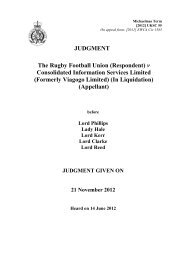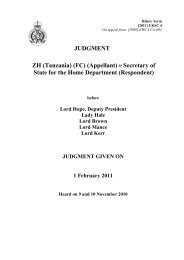Kuttan Menon Memorial Lecture Equality in the Judiciary Lady Hale ...
Kuttan Menon Memorial Lecture Equality in the Judiciary Lady Hale ...
Kuttan Menon Memorial Lecture Equality in the Judiciary Lady Hale ...
You also want an ePaper? Increase the reach of your titles
YUMPU automatically turns print PDFs into web optimized ePapers that Google loves.
<strong>Kuttan</strong> <strong>Menon</strong> <strong>Memorial</strong> <strong>Lecture</strong><br />
<strong>Equality</strong> <strong>in</strong> <strong>the</strong> <strong>Judiciary</strong><br />
<strong>Lady</strong> <strong>Hale</strong><br />
21 February 2013<br />
Thank you for ask<strong>in</strong>g me to give this lecture <strong>in</strong> memory of <strong>Kuttan</strong> <strong>Menon</strong>. I do not<br />
th<strong>in</strong>k that we ever met, but read<strong>in</strong>g Judge Goolam Meeran’s eloquent recollections of<br />
him <strong>in</strong> <strong>the</strong> first lecture <strong>in</strong> this series, 1 I very much wish that we had done. We clearly<br />
had quite a lot <strong>in</strong> common. We were called to <strong>the</strong> Bar at around <strong>the</strong> same time. We<br />
left it after only a few years <strong>in</strong> practice, he to be a legal officer at <strong>the</strong> Commission for<br />
Racial <strong>Equality</strong> and me for academia, but I seriously considered apply<strong>in</strong>g for <strong>the</strong><br />
equivalent of his post at <strong>the</strong> Equal Opportunities Commission when it was first<br />
advertised. We both returned to <strong>the</strong> Bar, he for some years and me for all of 11 days<br />
after leav<strong>in</strong>g <strong>the</strong> Law Commission. Nei<strong>the</strong>r of us, I am sure, planned on becom<strong>in</strong>g a<br />
judge. Judge Meeran says that when <strong>Kuttan</strong> mentioned <strong>the</strong> idea of becom<strong>in</strong>g an<br />
employment judge to him, he said “don’t be daft”. One of my professors said<br />
someth<strong>in</strong>g similar to me when <strong>the</strong> idea of becom<strong>in</strong>g an assistant recorder was<br />
suggested (<strong>in</strong> an old-fashioned tap on <strong>the</strong> shoulder). Fortunately nei<strong>the</strong>r of us took any<br />
notice.<br />
But of course <strong>the</strong> ma<strong>in</strong> th<strong>in</strong>g which we have <strong>in</strong> common is a commitment to<br />
combat<strong>in</strong>g discrim<strong>in</strong>ation and, more positively, to <strong>the</strong> pursuit of equal treatment. In<br />
this he was obviously more effective than I have been. He brought <strong>the</strong> first successful<br />
1 HHJ Goolam Meeran, “The early days of struggle and achievement <strong>in</strong> discrim<strong>in</strong>ation law”,<br />
First <strong>Kuttan</strong> <strong>Menon</strong> <strong>Memorial</strong> <strong>Lecture</strong> 2006.<br />
1
ace discrim<strong>in</strong>ation claim under <strong>the</strong> 1976 Act. He fought to get tribunal judges to<br />
understand <strong>in</strong>direct and unconscious discrim<strong>in</strong>ation and victimisation. 2 He won <strong>the</strong><br />
landmark decisions on draw<strong>in</strong>g <strong>in</strong>ferences and disclos<strong>in</strong>g comparative material. 3<br />
The problem he faced – and to some extent we still face – is gett<strong>in</strong>g people who have<br />
never suffered discrim<strong>in</strong>ation simply on <strong>the</strong> grounds of <strong>the</strong> colour of <strong>the</strong>ir sk<strong>in</strong> or <strong>the</strong><br />
difference <strong>in</strong> <strong>the</strong>ir chromosomes to understand what it is all about. As I have heard<br />
Dame Sian Elias, Chief Justice of New Zealand, say, it is difficult to understand <strong>the</strong><br />
humiliation suffered by people from visible m<strong>in</strong>orities – <strong>in</strong> her country <strong>the</strong> Maori and<br />
Pacific Islander populations – unless you too have suffered humiliation <strong>in</strong> your life, as<br />
she did when she was battl<strong>in</strong>g for recognition as a commercial lawyer <strong>in</strong> New<br />
Zealand.<br />
Which br<strong>in</strong>gs me to my subject. “In modern Brita<strong>in</strong>”, declared my bro<strong>the</strong>r Sumption<br />
<strong>in</strong> his Bar Council Law Reform <strong>Lecture</strong> last November, “<strong>the</strong> fastest way to make<br />
enemies is to deliver a public lecture about judicial diversity”. 4 If so, I must have<br />
made a lot of enemies s<strong>in</strong>ce I first started deliver<strong>in</strong>g lectures about it around <strong>the</strong> turn<br />
of <strong>the</strong> century. 5 I am go<strong>in</strong>g to start by tak<strong>in</strong>g it for granted that judicial diversity is a<br />
2<br />
Judge Meeran describes his victories <strong>in</strong> Wilson v T & B Steelworks (1977); Hussa<strong>in</strong> v Sa<strong>in</strong>ts<br />
Complete House Furnishers; Issa and Rashid v West Yorkshire Foundries; Malik v British Home<br />
Stores; Kirby v Manpower Services Commission [1980] 1 WLR 725.<br />
3<br />
K<strong>in</strong>g v Great Brita<strong>in</strong> Ch<strong>in</strong>a Centre [1991] IRLR 513, CA; Vyas v Leyland Cars [1980] AC<br />
1028.<br />
4<br />
“Home Truths about Judicial Diversity”, Bar Council Law Reform <strong>Lecture</strong> 2012.<br />
5<br />
Eg “<strong>Equality</strong> and <strong>the</strong> <strong>Judiciary</strong>: why should we want more women judges?” [2001] PL 489;<br />
“Mak<strong>in</strong>g a Difference? Why we need a more diverse judiciary” (2005) 56 NILQ 281; “The Future of<br />
<strong>the</strong> <strong>Judiciary</strong>”, <strong>Lecture</strong> at <strong>the</strong> open<strong>in</strong>g of Salford Law School 2006; “Women <strong>in</strong> <strong>the</strong> <strong>Judiciary</strong>”, <strong>Lecture</strong><br />
at Exeter University 2008; “It’s a Man’s World: Redress<strong>in</strong>g <strong>the</strong> Balance”, Norfolk Law <strong>Lecture</strong> 2012.<br />
2
good th<strong>in</strong>g. The Neuberger Advisory Panel on Judicial Diversity 6 summed up <strong>the</strong><br />
arguments which some of us have been mak<strong>in</strong>g for a long time <strong>in</strong> this way:<br />
“There is a strong case for judicial diversity. Not only should <strong>the</strong>re be<br />
equality of opportunity for those eligible to apply but <strong>in</strong> a democratic<br />
society <strong>the</strong> judiciary should reflect <strong>the</strong> diversity of society and <strong>the</strong> legal<br />
profession as a whole. Judges drawn from a wide range of backgrounds<br />
and life experiences will br<strong>in</strong>g vary<strong>in</strong>g perspectives to bear on critical<br />
legal issues. A judiciary which is visibly more reflective of society will<br />
enhance public confidence.”<br />
The debate is not about whe<strong>the</strong>r judicial diversity is a good th<strong>in</strong>g but about why it is<br />
and what should be done about it. And it raises an <strong>in</strong>terest<strong>in</strong>g conundrum <strong>in</strong> equality<br />
law which I would like to share with you. But first <strong>the</strong>re are some uncomfortable<br />
truths to be told whichever side one takes <strong>in</strong> <strong>the</strong> debate.<br />
First, it is an uncomfortable truth that we have so few women and BME judges,<br />
especially <strong>in</strong> <strong>the</strong> higher judiciary. 7 We all know <strong>the</strong> story. 22.5% of <strong>the</strong> judges <strong>in</strong> <strong>the</strong><br />
ord<strong>in</strong>ary courts – what tribunal judges call <strong>the</strong> uniform branch – are women and 4.2%<br />
are BME. It only gets that high by <strong>in</strong>clud<strong>in</strong>g <strong>the</strong> larger number of fee-paid part-timers,<br />
many of whom will never become full time judges. The figures are better <strong>in</strong> <strong>the</strong> CID.<br />
39.6% of tribunal judges are women and 8.7% are known to be BME. But this<br />
<strong>in</strong>cludes an even higher percentage of fee-paid part-timers.<br />
6 Report of <strong>the</strong> Advisory Panel on Judicial Diversity, chaired by Baroness Neuberger, February<br />
2010, p 4, accessible at www.equality-ne.co.uk.<br />
7 The figures as at April 2012 can be found at www.judiciary.gov.uk/publications-andreports/statistics/diversity-statistics-and-general-overview.<br />
They <strong>in</strong>clude tribunal judges for <strong>the</strong> first<br />
time.<br />
3
The figures are much worse when you get to <strong>the</strong> higher echelons <strong>in</strong> ei<strong>the</strong>r system.<br />
Only 26.6% of <strong>the</strong> upper tribunal judiciary are women, though 11% are BME. Only<br />
15.5% of High Court judges are women and 4.5% BME; 10.5% of Court of Appeal<br />
judges are women and no BME; none of <strong>the</strong> five heads of division is a woman or<br />
BME; and <strong>in</strong> <strong>the</strong> Supreme Court <strong>the</strong>re is still only me and <strong>the</strong> only ethnic m<strong>in</strong>orities<br />
we have are <strong>the</strong> Scots and <strong>the</strong> Irish.<br />
Second, it is an uncomfortable truth that we are out of step with <strong>the</strong> rest of <strong>the</strong> world,<br />
at least <strong>in</strong> <strong>the</strong> gender of our judges. The average across <strong>the</strong> countries <strong>in</strong> <strong>the</strong> Council of<br />
Europe is 52% men and 48% women. At 23% England and Wales is fourth from <strong>the</strong><br />
bottom, followed only by Azebaijan, Scotland and Armenia. 8 It is fair to say,<br />
however, that, across Europe, <strong>the</strong> gender balance gets worse <strong>the</strong> higher <strong>the</strong> court.<br />
Professor Paterson at Strathclyde University has compared <strong>the</strong> proportion of women<br />
<strong>in</strong> <strong>the</strong> highest courts of <strong>the</strong> 34 countries <strong>in</strong> <strong>the</strong> OECD. At 8.0%, we were at rock<br />
bottom, albeit closely followed by Turkey. Even <strong>the</strong> o<strong>the</strong>r common law countries are<br />
currently much better than us: three out of <strong>the</strong> n<strong>in</strong>e <strong>in</strong> <strong>the</strong> Supreme Court of <strong>the</strong><br />
United States; three out of <strong>the</strong> n<strong>in</strong>e <strong>in</strong> <strong>the</strong> Supreme Court of Canada; three out of <strong>the</strong><br />
seven <strong>in</strong> <strong>the</strong> High Court of Australia; two out of five <strong>in</strong> <strong>the</strong> Supreme Court of New<br />
Zealand. Of course, not too much can be made of this when <strong>the</strong> numbers are so small<br />
but aga<strong>in</strong>st this picture one out of (currently) eleven does not look good.<br />
8<br />
European Commission for <strong>the</strong> Efficiency of Justice (cepej), European Judicial Systems,<br />
Edition 2012 (2010 date), fig 11.30.<br />
4
Third, it is an uncomfortable truth that so many of our top judges come from such<br />
similar educational and professional backgrounds and this often but not <strong>in</strong>variably<br />
means that <strong>the</strong>y also come from similar socio-economic backgrounds. It is much<br />
harder to get reliable data on this. The Milburn Report showed that around 75% of<br />
judges, 68% of top barristers, and even 55% of solicitors were privately educated<br />
(though <strong>the</strong>se percentages had decreased from <strong>the</strong> mid-1980s). It also showed that<br />
lawyers typically grew up <strong>in</strong> families with an <strong>in</strong>come 64% above <strong>the</strong> national average,<br />
a rise from around 40% between <strong>the</strong> 1958 and 1970 birth cohorts. 9<br />
My brethren <strong>in</strong> <strong>the</strong> Supreme Court are a good illustration. They are a very varied<br />
bunch <strong>in</strong> some ways but <strong>the</strong>y mostly fit <strong>the</strong> stereotypical pattern of boys’ board<strong>in</strong>g<br />
school, Oxbridge college and <strong>the</strong> Inns of Court. All of <strong>the</strong>m were very successful<br />
barristers <strong>in</strong> private practice before go<strong>in</strong>g on <strong>the</strong> bench, although two did o<strong>the</strong>r th<strong>in</strong>gs<br />
first (I was not). All but one of <strong>the</strong>m has a degree from Oxford or Cambridge (as<br />
<strong>in</strong>deed do I). 10 All but one of <strong>the</strong>m went to an <strong>in</strong>dependent fee-pay<strong>in</strong>g school (I did<br />
not). 11 Indeed all but three of <strong>the</strong>m went to boys’ board<strong>in</strong>g schools (whereas I only<br />
lived <strong>in</strong> one). 12<br />
Please do not th<strong>in</strong>k that I am criticis<strong>in</strong>g <strong>the</strong>m for this. For one th<strong>in</strong>g, <strong>the</strong>y cannot be<br />
blamed for <strong>the</strong>ir good fortune. For ano<strong>the</strong>r, however great your advantages <strong>in</strong> life, you<br />
have to have <strong>the</strong> bra<strong>in</strong>s, <strong>the</strong> energy, <strong>the</strong> determ<strong>in</strong>ation and <strong>the</strong> good luck to make <strong>the</strong><br />
most of <strong>the</strong>m. And for a third, this comb<strong>in</strong>ation of educational establishments turns<br />
9<br />
Unleash<strong>in</strong>g Aspiration: The F<strong>in</strong>al Report of <strong>the</strong> Panel on Fair Access to <strong>the</strong> Professions Cair,<br />
Alan Milburn MP), accessible at www.cab<strong>in</strong>etoffice.gov.uk/media/227102/fair-access.pdf.<br />
10<br />
The exception is Lord Kerr, who was educated at Queen’s University, Belfast; both Lord<br />
Hope and Lord Reed also have degrees from Ed<strong>in</strong>burgh University.<br />
11<br />
Aga<strong>in</strong> <strong>the</strong> exception is Lord Kerr, who went to a Roman Catholic grammar school <strong>in</strong> Nor<strong>the</strong>rn<br />
Ireland.<br />
12<br />
The exceptions are Lord Neuberger, Lord Kerr and Lord Reid.<br />
5
out some of <strong>the</strong> best-educated people <strong>in</strong> <strong>the</strong> country. But it also br<strong>in</strong>gs advantages <strong>in</strong><br />
o<strong>the</strong>r ways, <strong>in</strong> who you know as well as what you know, and this can smooth your<br />
path and open doors which might rema<strong>in</strong> closed to o<strong>the</strong>rs. It can also br<strong>in</strong>g with it <strong>the</strong><br />
expectation that this will happen, an expectation which people from more modest<br />
educational backgrounds simply do not have.<br />
On <strong>the</strong> o<strong>the</strong>r hand, it is an uncomfortable truth that our present unrepresentative<br />
judiciary are, apparently, very widely admired <strong>in</strong> <strong>the</strong> outside world. The Russian<br />
oligarchs want to litigate here because of <strong>the</strong>ir <strong>in</strong>telligence, <strong>the</strong>ir <strong>in</strong>dustry, <strong>the</strong>ir<br />
<strong>in</strong>dependence, <strong>the</strong>ir <strong>in</strong>tegrity and <strong>the</strong>ir <strong>in</strong>corruptibility – what I call <strong>the</strong> essential<br />
judicial <strong>in</strong>-quotients. Could this be anyth<strong>in</strong>g to do with who <strong>the</strong>y are?<br />
It is ano<strong>the</strong>r uncomfortable truth that our judiciary are better paid than almost any <strong>in</strong><br />
Europe. 13 This is one of <strong>the</strong> many reasons why <strong>the</strong>y are <strong>in</strong>corruptible. And it clearly<br />
does have a lot to do with who <strong>the</strong>y are. If you assume that you are go<strong>in</strong>g to recruit<br />
your top judges from your top practitioners, <strong>the</strong>n you have to pay <strong>the</strong>m enough to<br />
make it worth <strong>the</strong>ir while. And it is not only <strong>the</strong> top judges. At all levels, people come<br />
<strong>in</strong>to <strong>the</strong> judiciary hav<strong>in</strong>g already achieved someth<strong>in</strong>g <strong>in</strong> <strong>the</strong>ir professional lives. The<br />
rewards have to bear some relationship to <strong>the</strong> rewards of <strong>the</strong>ir o<strong>the</strong>r careers.<br />
It is a f<strong>in</strong>al uncomfortable truth that <strong>the</strong> status and pay of judges <strong>in</strong> countries where<br />
<strong>the</strong>re are far more women judges tend to be much lower than <strong>the</strong>y are here. 14 We can<br />
argue about whe<strong>the</strong>r this is chicken or egg: are <strong>the</strong> status and pay lower because so<br />
many of <strong>the</strong>m are women or are so many of <strong>the</strong>m women because <strong>the</strong> status and pay<br />
13 European Judicial Systems, note 8 above, figs 11.15, 11.19 and 11.23.<br />
14 Ibid, cf fig 11.23 and fig 11.30.<br />
6
are lower? In o<strong>the</strong>r words, because women are prepared to take lower paid and lower<br />
status jobs for a variety of reasons, <strong>in</strong>clud<strong>in</strong>g <strong>the</strong>ir domestic responsibilities? I <strong>in</strong>cl<strong>in</strong>e<br />
to th<strong>in</strong>k that <strong>the</strong> latter is <strong>the</strong> correct explanation, for two ma<strong>in</strong> reasons: first, because<br />
many of <strong>the</strong> countries <strong>in</strong> which <strong>the</strong>re are now so many women judges are civil law<br />
countries where <strong>the</strong>re are many more judges anyway and that is one reason why <strong>the</strong>y<br />
do not pay <strong>the</strong>m so much; <strong>the</strong>y also recruit by exam<strong>in</strong>ation and young women are<br />
notoriously better at exam<strong>in</strong>ations than young men; and second, because some of<br />
<strong>the</strong>m are former eastern bloc countries where one would not expect <strong>the</strong> status of<br />
judges to be particularly high.<br />
It is this comb<strong>in</strong>ation of uncomfortable truths which leads some people to fear that, if<br />
we changed <strong>the</strong> system so radically that <strong>the</strong> composition of our higher judiciary also<br />
changed radically, we might not like what we saw. In fact, might it not be a whole lot<br />
worse? Would a radical <strong>in</strong>crease <strong>in</strong> <strong>the</strong> numbers of women and BME judges lead <strong>in</strong><br />
time to lower pay, lower status and ultimately to a less able judiciary? I raise this<br />
demon, not because I believe <strong>in</strong> it, but because I fear that <strong>the</strong>re are some who do, but<br />
may not wish to say so publicly.<br />
Despite that, one of <strong>the</strong> biggest changes I have seen over <strong>the</strong> past two decades is that<br />
more and more people have come to recognise that we do have a problem. Authors as<br />
diverse as David Pannick <strong>in</strong> 1987 15 and Helena Kennedy <strong>in</strong> 1993 16 began to raise<br />
questions about <strong>the</strong> composition and appo<strong>in</strong>tment of <strong>the</strong> judiciary. JUSTICE proposed<br />
an <strong>in</strong>dependent judicial appo<strong>in</strong>tments commission as long ago as 1992. 17 Successive<br />
15<br />
Judges, Oxford University Press 1987, pp 59-60.<br />
16<br />
Eve was Framed: Women and British Justice, Chatto & W<strong>in</strong>dus, 1992, V<strong>in</strong>tage Books, 1993,<br />
esp pp 265 et seq.<br />
17<br />
JUSTICE Report on <strong>the</strong> <strong>Judiciary</strong> <strong>in</strong> England and Wales, 1992.<br />
7
Lord Chancellors, beg<strong>in</strong>n<strong>in</strong>g with Lord MacKay, began to make a difference. The<br />
Lord Chief Justice, Lord Taylor, acknowledged <strong>in</strong> 1992 that th<strong>in</strong>gs needed to change<br />
but thought that <strong>the</strong>y soon would, as <strong>the</strong> talented women now jo<strong>in</strong><strong>in</strong>g <strong>the</strong> profession<br />
began to “trickle up”.<br />
The pace hotted up after <strong>the</strong> 1997 election. The Labour party had already adopted<br />
proposals for a judicial appo<strong>in</strong>tments and tra<strong>in</strong><strong>in</strong>g commission. 18 The legal<br />
professions set up a Jo<strong>in</strong>t Work<strong>in</strong>g Party on Equal Opportunities and Silk which<br />
reported <strong>in</strong> 1999. The Law Society’s had adopted a particularly far-sighted policy: an<br />
<strong>in</strong>dependent appo<strong>in</strong>tments commission; a modernised appo<strong>in</strong>tments process with no<br />
secret sound<strong>in</strong>gs; widen<strong>in</strong>g <strong>the</strong> pool of candidates; and develop<strong>in</strong>g a coherent judicial<br />
career structure. 19 Once <strong>in</strong> office, however, Lord Irv<strong>in</strong>e dropped plans to consult on a<br />
judicial appo<strong>in</strong>tments commission and <strong>in</strong>stead set up Sir Leonard Peach’s enquiry <strong>in</strong>to<br />
<strong>the</strong> appo<strong>in</strong>tments process. 20 The result was <strong>the</strong> appo<strong>in</strong>tment of a Commission for<br />
Judicial Appo<strong>in</strong>tments to scrut<strong>in</strong>ise his Department’s processes. The f<strong>in</strong>d<strong>in</strong>gs made<br />
uncomfortable read<strong>in</strong>g. In June 2003, as part of <strong>the</strong> package aimed at abolish<strong>in</strong>g <strong>the</strong><br />
ancient office of Lord Chancellor, <strong>the</strong> Government announced that it would be<br />
consult<strong>in</strong>g upon an <strong>in</strong>dependent judicial appo<strong>in</strong>tments commission. 21 This became<br />
official Government policy <strong>in</strong> 2004.<br />
18<br />
Labour Party, Access to Justice: Labour’s proposals for reform<strong>in</strong>g <strong>the</strong> civil justice system,<br />
Conference paper, 1995.<br />
19<br />
The Law Society, Broaden<strong>in</strong>g <strong>the</strong> Bench: <strong>the</strong> Law Society proposals for reform<strong>in</strong>g <strong>the</strong> way<br />
judges are appo<strong>in</strong>ted (2000).<br />
20<br />
Sir Leonard Peach, An Independent Scrut<strong>in</strong>y of <strong>the</strong> Appo<strong>in</strong>tments Process of Judges and<br />
Queen’s Counsel <strong>in</strong> England and Wales, December 1999.<br />
21<br />
See Department for Constitutional Affairs, Constitutional reform: a new way of appo<strong>in</strong>t<strong>in</strong>g<br />
judges, CP 10/03, July 2003.<br />
8
There was more than one reason for this. Once <strong>the</strong> responsible m<strong>in</strong>ister no longer had<br />
to be a very senior and well-respected lawyer, qualified to head <strong>the</strong> judiciary, people<br />
were concerned about <strong>the</strong> <strong>in</strong>fluence of party politics on judicial appo<strong>in</strong>tments. We had<br />
not had party politically motivated appo<strong>in</strong>tments for a long time, possibly s<strong>in</strong>ce <strong>the</strong><br />
second world war, and no-one wants a system which looks anyth<strong>in</strong>g like <strong>the</strong><br />
partisanship of <strong>the</strong> American courts. So while <strong>the</strong> <strong>in</strong>itial proposal was that five names<br />
would be put up to <strong>the</strong> Lord Chancellor for <strong>the</strong> most senior judicial appo<strong>in</strong>tments, this<br />
was eventually withdrawn, and only one name can be put forward. His options if he is<br />
uncomfortable with that name are very limited. 22 So we have gone from a process<br />
which, ostensibly, was solely <strong>in</strong> <strong>the</strong> hands of a political figure, to a process <strong>in</strong> which<br />
he has very little <strong>in</strong>fluence at all. Yet <strong>the</strong>re seems to be general (though not universal)<br />
support, and certa<strong>in</strong>ly from <strong>the</strong> House of Lords Constitution Committee, for this<br />
withdrawal of <strong>the</strong> politically accountable Parliamentarians from <strong>the</strong> selection<br />
process. 23<br />
But a major motivation for <strong>the</strong> change was to <strong>in</strong>crease <strong>the</strong> diversity of <strong>the</strong> bench at all<br />
levels. This too provoked a reaction <strong>in</strong> Parliament, because so many people thought<br />
that merit and diversity are compet<strong>in</strong>g ra<strong>the</strong>r than complementary values. So <strong>the</strong><br />
proposal from <strong>the</strong> Jo<strong>in</strong>t Committee on Human Rights, 24 that <strong>the</strong>re should be a duty<br />
ak<strong>in</strong> to that <strong>in</strong> Nor<strong>the</strong>rn Ireland, to appo<strong>in</strong>t a judiciary reflective of <strong>the</strong> community it<br />
serves, 25 was rejected. Instead <strong>the</strong>re is a duty to “have regard to <strong>the</strong> need to encourage<br />
22<br />
See, eg, his powers <strong>in</strong> relation to appo<strong>in</strong>tments to <strong>the</strong> Supreme Court, Constitutional Reform<br />
Act 2005, ss 28 to 31.<br />
23 th<br />
House of Lords, Select Committee on <strong>the</strong> Constitution, 25 Report of Session 2010-2012,<br />
Judicial Appo<strong>in</strong>tments, HL Paper 272; cf, eg, <strong>the</strong> evidence from JUSTICE and from <strong>the</strong> Equal Justices<br />
Initiative.<br />
24 rd<br />
Jo<strong>in</strong>t Committee on Human Rights, 23 Report of Session 2003-2004, Scrut<strong>in</strong>y of Bills: F<strong>in</strong>al<br />
Progress Report, para 1.83.<br />
25<br />
Justice (Nor<strong>the</strong>rn Ireland) Act 2004, s 3.<br />
9
diversity <strong>in</strong> <strong>the</strong> range of persons available for selection” (s 64(1)). But this is subject<br />
to section 63(2), which provides that selection must be “solely on merit”. So, as some<br />
of us have always known, it is not enough to get <strong>the</strong> appo<strong>in</strong>tments process right,<br />
though that is hard enough. We have to get <strong>the</strong> def<strong>in</strong>ition and assessment of merit<br />
right too and that is much harder.<br />
Six years on <strong>the</strong>re has undoubtedly been some progress. More women and BME<br />
candidates are apply<strong>in</strong>g and be<strong>in</strong>g appo<strong>in</strong>ted. The figures quoted earlier,<br />
uncomfortable though <strong>the</strong>y are, are a good deal better than <strong>the</strong> figures of ten years<br />
ago. But it was always a mistake to th<strong>in</strong>k that transferr<strong>in</strong>g appo<strong>in</strong>tments from <strong>the</strong> Lord<br />
Chancellor to <strong>the</strong> Commission would do <strong>the</strong> trick. For one th<strong>in</strong>g, <strong>the</strong> system was<br />
already beg<strong>in</strong>n<strong>in</strong>g to change. As Lord Sumption has po<strong>in</strong>ted out, under <strong>the</strong> old “tap on<br />
<strong>the</strong> shoulder” system <strong>the</strong> Lord Chancellor’s Department depended almost entirely<br />
upon <strong>the</strong> <strong>in</strong>formation supplied by <strong>the</strong> judges to know whose shoulder to tap. He does<br />
not believe that <strong>the</strong> judges were “out to clone <strong>the</strong>mselves”, to utilise Helena<br />
Kennedy’s evocative expression. 26 But, he cont<strong>in</strong>ues, “it would be foolish to pretend<br />
that <strong>the</strong>y were not occasionally <strong>in</strong>fluenced by unconscious stereotyp<strong>in</strong>g and by<br />
perceptions of ability moulded by <strong>the</strong>ir own personal experiences”. I would merely<br />
drop <strong>the</strong> “occasionally”. And of course <strong>the</strong>y were only fish<strong>in</strong>g <strong>in</strong> <strong>the</strong> conventional<br />
pool.<br />
However, by <strong>the</strong> time <strong>the</strong> JAC was set up, <strong>the</strong> great majority of appo<strong>in</strong>tments up to<br />
and <strong>in</strong>clud<strong>in</strong>g <strong>the</strong> High Court were based on applications ra<strong>the</strong>r than taps on <strong>the</strong><br />
shoulder. The qualities thought to comprise merit had been made public. The methods<br />
26 Eve was Framed, op cit, p 267.<br />
10
of assess<strong>in</strong>g <strong>the</strong>se were be<strong>in</strong>g ref<strong>in</strong>ed. The Commission simply carried on <strong>the</strong>se<br />
developments with, I would suggest, more enthusiasm and more <strong>in</strong>dependent<br />
specialist knowledge of <strong>the</strong> best recruitment practices. They have also taken many<br />
more active steps to encourage under-represented groups to consider a judicial career.<br />
But <strong>the</strong>re was still concern at <strong>the</strong> slow rate of progress. In 2009, <strong>the</strong> new Lord<br />
Chancellor and Secretary of State for Justice, Jack Straw, appo<strong>in</strong>ted an Advisory<br />
Panel on Judicial Diversity, chaired by Baroness Neuberger, which reported <strong>in</strong> 2010. 27<br />
The politicians and Parliamentarians have kept up <strong>the</strong> momentum. In 2011, <strong>the</strong><br />
House of Lords Constitution Committee launched an <strong>in</strong>quiry <strong>in</strong>to judicial<br />
appo<strong>in</strong>tments, which reported <strong>in</strong> March 2012, 28 and <strong>the</strong> M<strong>in</strong>istry of Justice itself<br />
proposed a few modest reforms, some of which were aimed at <strong>in</strong>creas<strong>in</strong>g diversity. 29<br />
The ma<strong>in</strong> message to emerge from all this activity is that process of choos<strong>in</strong>g <strong>the</strong> best<br />
candidates is only part of <strong>the</strong> story. It is but one episode <strong>in</strong> a long runn<strong>in</strong>g serial.<br />
Ei<strong>the</strong>r side of <strong>the</strong> JAC <strong>the</strong>re sit episodes <strong>in</strong> <strong>the</strong> saga which tend to disadvantage non-<br />
standard candidates. This beg<strong>in</strong>s with our education system, which, as Lord Sumption<br />
puts it “tends to perpetuate disadvantage”, or as o<strong>the</strong>rs might put it, “tends to<br />
perpetuate advantage”. The Sutton Trust has shown that students from <strong>in</strong>dependent<br />
schools are more likely to go to Oxbridge and o<strong>the</strong>r top universities than are state<br />
school students with <strong>the</strong> same grades – not necessarily because <strong>the</strong> universities are<br />
discrim<strong>in</strong>at<strong>in</strong>g but because <strong>the</strong> state school students are not apply<strong>in</strong>g. 30 Recruitment to<br />
27<br />
Op cit, note 6.<br />
28<br />
Op cit, note 23.<br />
29 st<br />
M<strong>in</strong>istry of Justice, Appo<strong>in</strong>tments and Diversity: A <strong>Judiciary</strong> for <strong>the</strong> 21 Century, CP 19/2011,<br />
November 2011.<br />
30<br />
Sutton Trust, The Miss<strong>in</strong>g 3000, State School Students under-represented at lead<strong>in</strong>g<br />
Universities, 2004; Sutton Trust, State School Admissions to our Lead<strong>in</strong>g Universities, An update to<br />
11
law jobs, whe<strong>the</strong>r as barristers or solicitors, is left to <strong>the</strong> market. The market favours a<br />
small number of top universities. An Oxbridge graduate with a non-law or lower<br />
class law degree is more likely to be recruited than a post-1992 university graduate<br />
with a first class law degree.<br />
The serial cont<strong>in</strong>ues with what Lord Sumption calls “<strong>the</strong> patterns of work<strong>in</strong>g <strong>in</strong><br />
ancient professions”. For <strong>the</strong> Bar, this means all <strong>the</strong> reasons why many able but<br />
sensible women choose ei<strong>the</strong>r to go <strong>in</strong>to ano<strong>the</strong>r branch of <strong>the</strong> profession or to leave<br />
<strong>the</strong> Bar after giv<strong>in</strong>g it a go for a few years. I was once foolish enough to say that <strong>the</strong><br />
Bar was one of <strong>the</strong> most family unfriendly professions <strong>in</strong> <strong>the</strong> world. 31 I was properly<br />
taken to task by a successful woman silk, who compla<strong>in</strong>ed that I would put able<br />
young women off com<strong>in</strong>g to <strong>the</strong> Bar by such accusations. Of course, it is possible to<br />
“have it all” if you have <strong>the</strong> sort of practice which pays so much for <strong>in</strong>dividual cases<br />
that you can afford to pick and choose between <strong>the</strong>m, to live close to your work, to<br />
employ a nanny and o<strong>the</strong>r help <strong>in</strong> <strong>the</strong> house, to send <strong>the</strong> children away to board<strong>in</strong>g<br />
school and so on. It also helps to have a supportive partner. But that is not <strong>the</strong> life<br />
which I experienced at <strong>the</strong> common law Bar <strong>in</strong> <strong>the</strong> 1970s and I do not believe that it is<br />
<strong>the</strong> life that many young women experience at <strong>the</strong> Bar <strong>the</strong>se days. If it was <strong>the</strong>re<br />
would not be such a steady rate of attrition. 32 If <strong>the</strong> Bar were really serious about<br />
help<strong>in</strong>g young women to stay <strong>in</strong> <strong>in</strong>dependent practice, it would have done more to<br />
support <strong>the</strong> project to set up a Bar nursery.<br />
‘The Miss<strong>in</strong>g 3000’, March 2005; Sutton Trust, Sutton Trust Submission to Sir Mart<strong>in</strong> Harris:<br />
Widen<strong>in</strong>g Access to Selective Universities, January 2010.<br />
31<br />
“An exclusive <strong>in</strong>terview with <strong>Lady</strong> <strong>Hale</strong>, 16 September 2010, accessible at<br />
www.ukscblog.com.<br />
32<br />
Bar Council, Bar Barometer: Trends <strong>in</strong> <strong>the</strong> Profile of <strong>the</strong> Bar, December 2011; December<br />
2012.<br />
12
For <strong>the</strong> solicitors’ profession, <strong>the</strong> patterns of work may be ra<strong>the</strong>r different, but <strong>the</strong><br />
pressures of “presenteeism” <strong>in</strong> <strong>the</strong> top City firms are very like <strong>the</strong> pressures I see upon<br />
my <strong>in</strong>vestment bank<strong>in</strong>g daughter and <strong>the</strong>y are very hard to comb<strong>in</strong>e with a normal<br />
family life. The o<strong>the</strong>r problem, as we all know, is that many solicitors’ firms do not<br />
value judicial appo<strong>in</strong>tments <strong>in</strong> <strong>the</strong> way that <strong>the</strong> Bar traditionally has done. So <strong>the</strong>y are<br />
not keen for <strong>the</strong>ir partners to take <strong>the</strong> part time fee-paid appo<strong>in</strong>tments which <strong>the</strong>se<br />
days are an essential stepp<strong>in</strong>g stone to greater th<strong>in</strong>gs.<br />
Lord Sumption also refers to “unspoken, often unconscious, attitudes which have<br />
been many years <strong>in</strong> <strong>the</strong> mak<strong>in</strong>g”. It is not difficult to imag<strong>in</strong>e what he means. It is,<br />
after all, not very long ago that women barristers and judges were not allowed to wear<br />
trousers <strong>in</strong> court, but were expected (and probably wanted ) to wear men’s wigs, and<br />
(<strong>in</strong> <strong>the</strong> case of Dame Elizabeth Butler-Sloss) were addressed as “My Lord”. Pretty<br />
young women elected to <strong>the</strong> Nor<strong>the</strong>rn Circuit were expected to get up on <strong>the</strong> table<br />
(although not, as I recall, to dance round a pole).<br />
Tell<strong>in</strong>gly, of course, he refers to <strong>the</strong> “ancient professions”. One of <strong>the</strong> pr<strong>in</strong>cipal<br />
differences between this country and <strong>the</strong> rest of <strong>the</strong> common law world is that we still<br />
have a divided legal profession. This means that we have a comparatively small class<br />
of people who are seen as natural candidates for <strong>the</strong> bench, particularly <strong>in</strong> <strong>the</strong> higher<br />
courts. They are, because of <strong>the</strong> pressures under which <strong>the</strong>y work, remarkably able,<br />
hard-work<strong>in</strong>g, <strong>in</strong>dependent-m<strong>in</strong>ded and courageous people. They also know what <strong>the</strong><br />
courts are all about. And <strong>the</strong>y are known to <strong>the</strong> judges whose views still count for<br />
someth<strong>in</strong>g when it comes to judicial appo<strong>in</strong>tments.<br />
13
So it is not surpris<strong>in</strong>g that <strong>the</strong>re are stereotypes about who gets what sort of judicial<br />
job. Not long ago, it was taken for granted that only <strong>the</strong> top silks were qualified for<br />
appo<strong>in</strong>tment to <strong>the</strong> High Court bench. Successful senior juniors would qualify for <strong>the</strong><br />
Circuit Bench. Solicitors would become county court registrars and stipendiary<br />
magistrates (not yet called judges). A much wider variety of professional lawyers,<br />
<strong>in</strong>clud<strong>in</strong>g quite a few who practised as academics, might become tribunal chairs. In<br />
recent years, we have seen a t<strong>in</strong>y number of solicitors become High Court judges; a<br />
much larger number of silks and solicitors become Circuit Judges; and barristers also<br />
becom<strong>in</strong>g district judges. But <strong>the</strong> percentage of “non-barristers” listed aga<strong>in</strong>st each<br />
judicial post <strong>in</strong> <strong>the</strong> official statistics bears out <strong>the</strong> traditional assumptions: <strong>the</strong>y are<br />
less than 2% <strong>in</strong> <strong>the</strong> High Court and above but gett<strong>in</strong>g on for 90% of District Judges<br />
and 69% of tribunal judges (<strong>in</strong>terest<strong>in</strong>gly, <strong>the</strong> figure is much <strong>the</strong> same <strong>in</strong> both upper<br />
and first-tier tribunals).<br />
Of course it is possible to argue that this is because <strong>the</strong>y are <strong>the</strong> best qualified for <strong>the</strong><br />
job. But I am simply not prepared to make that assumption. It is not made <strong>in</strong> o<strong>the</strong>r<br />
countries, such as Canada and Israel. It feels both self-seek<strong>in</strong>g and implausible – self-<br />
seek<strong>in</strong>g because it reserves <strong>the</strong> top jobs for <strong>the</strong> top barristers, only 12% of whom are<br />
women – and implausible because any University teacher can list many able graduates<br />
who could have made excellent judges but who went <strong>in</strong>to a different branch of <strong>the</strong><br />
law.<br />
The next episode <strong>in</strong> <strong>the</strong> saga consists of <strong>the</strong> written or unwritten requirements for<br />
judicial appo<strong>in</strong>tment. These days, you are most unlikely to get a salaried appo<strong>in</strong>tment<br />
unless you have previously sat as a fee-paid part-timer at <strong>the</strong> same level. The good<br />
14
side to this is that people can be tried out, and people can try out <strong>the</strong> job, before ei<strong>the</strong>r<br />
side is committed to an appo<strong>in</strong>tment from which judicial <strong>in</strong>dependence means that, <strong>in</strong><br />
reality, <strong>the</strong>y cannot be sacked. The bad side is that you have to get on <strong>the</strong> ladder. But<br />
it is worse than that, because you won’t get a High Court appo<strong>in</strong>tment unless you<br />
have sat as a deputy high court judge and until recently that was <strong>in</strong> <strong>the</strong> hands of <strong>the</strong><br />
Heads of Division. Nor will you be thought eligible for, say, <strong>the</strong> Family Division<br />
unless you have already been ticketed to do public law family work. And <strong>the</strong> ticket<strong>in</strong>g<br />
system has noth<strong>in</strong>g to do with <strong>the</strong> JAC. It depends upon <strong>the</strong> bus<strong>in</strong>ess case as well as<br />
suitability. So <strong>the</strong>re are some very able specialists who might be well suited to a High<br />
Court appo<strong>in</strong>tment who will not be thought eligible because <strong>the</strong>y have not been<br />
granted <strong>the</strong> appropriate tickets.<br />
Hence <strong>the</strong> ma<strong>in</strong> defects <strong>in</strong> <strong>the</strong> current system, argues Lord Sumption, are <strong>the</strong> lack of<br />
any facilities to tra<strong>in</strong> newly appo<strong>in</strong>ted judges before <strong>the</strong>y take up <strong>the</strong>ir appo<strong>in</strong>tments<br />
and <strong>the</strong> “highly prescriptive job descriptions” prepared by <strong>the</strong> Courts Service and<br />
M<strong>in</strong>istry of Justice. The requirement is for people who can “hit <strong>the</strong> ground runn<strong>in</strong>g”<br />
ra<strong>the</strong>r hav<strong>in</strong>g time to work <strong>the</strong>mselves <strong>in</strong>. This, he says, puts pressure on <strong>the</strong><br />
Commission to choose “safe” candidates <strong>in</strong> preference to those with less experience<br />
but greater potential. He says that <strong>the</strong> Commission is quite good at resist<strong>in</strong>g <strong>the</strong>se<br />
pressures but it cannot ignore <strong>the</strong>m altoge<strong>the</strong>r. This is where he would welcome some<br />
change and, of course, so would I, because it is just this sort of pressure which makes<br />
it difficult for non-standard candidates to be taken seriously.<br />
The f<strong>in</strong>al episode <strong>in</strong> <strong>the</strong> saga is <strong>the</strong> lack of a proper judicial career structure which<br />
enables those who do have a salaried judicial appo<strong>in</strong>tment to make progress through<br />
15
<strong>the</strong> ranks. At least <strong>the</strong> armed forces are only divided <strong>in</strong>to officers and o<strong>the</strong>r ranks for<br />
entry purposes. The judiciary are divided <strong>in</strong>to four: <strong>the</strong> “officers”, <strong>the</strong> High Court and<br />
above, <strong>the</strong> “non-commissioned officers”, <strong>the</strong> Circuit Bench and some equivalents, and<br />
<strong>the</strong> “o<strong>the</strong>r ranks”, <strong>the</strong> district judges and <strong>the</strong>ir equivalents and <strong>the</strong> “unranked”, <strong>the</strong><br />
salaried tribunal judges. There is direct entry, after a period of part time service, at<br />
every level. Those hop<strong>in</strong>g for promotion from one level to ano<strong>the</strong>r have to compete<br />
with <strong>the</strong> direct entry candidates and may face a variety of difficulties <strong>in</strong> do<strong>in</strong>g so.<br />
So it is not surpris<strong>in</strong>g that <strong>the</strong> ma<strong>in</strong> message from Baroness Neuberger and <strong>the</strong> House<br />
of Lords is that we need to br<strong>in</strong>g about change <strong>in</strong> as many of <strong>the</strong>se episodes as we<br />
can. The legal professions, as well as <strong>the</strong> Court Service, <strong>the</strong> M<strong>in</strong>istry of Justice, <strong>the</strong><br />
Lord Chancellor and <strong>the</strong> leaders of <strong>the</strong> judiciary, have to try to attack each of <strong>the</strong>se<br />
obstacles to fur<strong>the</strong>r progress. The pr<strong>in</strong>cipal recommendation of <strong>the</strong> Neuberger panel<br />
was that “There should be a fundamental shift of approach from a focus on <strong>in</strong>dividual<br />
judicial appo<strong>in</strong>tments to <strong>the</strong> concept of a judicial career. A judicial career should be<br />
able to span roles <strong>in</strong> <strong>the</strong> courts and tribunals as one unified judiciary.” 33<br />
My own shopp<strong>in</strong>g list would emphasise <strong>the</strong> need to look for and encourage top quality<br />
candidates from wherever <strong>the</strong>y might be found among those who profess <strong>the</strong> law. This<br />
would <strong>in</strong>clude tackl<strong>in</strong>g <strong>the</strong> prescriptive job descriptions and lack of tra<strong>in</strong><strong>in</strong>g. It would<br />
no doubt entail some changes <strong>in</strong> <strong>the</strong> selection processes, which can seem designed to<br />
favour those who are already familiar with <strong>the</strong> jurisdiction <strong>in</strong> question over those who<br />
with <strong>the</strong> greater potential. And it would entail giv<strong>in</strong>g some serious thought to <strong>the</strong><br />
structure of <strong>the</strong> judicial profession as a whole. This would <strong>in</strong>clude methods of<br />
33 Op cit, note 6, recommendation 1, p 7.<br />
16
work<strong>in</strong>g, because some features of <strong>the</strong> judicial life are likely to deter some very able<br />
candidates from apply<strong>in</strong>g. 34 All of this would make it more likely that able candidates<br />
from non-standard professional backgrounds would be appo<strong>in</strong>ted and that <strong>in</strong> itself<br />
would be likely to improve diversity.<br />
All this amounts to affirmative action but it does not amount to positive<br />
discrim<strong>in</strong>ation. Thus far Lord Sumption and I largely agree about <strong>the</strong> diagnosis of <strong>the</strong><br />
problem, although we may not always agree about which parts of <strong>the</strong> explanation are<br />
a bad th<strong>in</strong>g. Where I respectfully disagree (as we judges say) with Lord Sumption is<br />
<strong>in</strong> his belief that we will not make quicker progress (if it would be progress) without<br />
some measure of positive discrim<strong>in</strong>ation which he th<strong>in</strong>ks would be a bad th<strong>in</strong>g. I<br />
disagree because I th<strong>in</strong>k that tackl<strong>in</strong>g <strong>the</strong> above obstacles would make a considerable<br />
difference if it were done with <strong>the</strong> right amount of enthusiasm. I was glad to see that<br />
<strong>the</strong> House of Lords Constitution Committee did not see merit as narrowly def<strong>in</strong>ed and<br />
certa<strong>in</strong>ly did not see high quality advocacy as a necessary component. 35 But <strong>the</strong>n I<br />
would say that, wouldn’t I, not hav<strong>in</strong>g been a high quality advocate myself, except <strong>in</strong><br />
Faculty meet<strong>in</strong>gs?<br />
The House of Lords Constitution Committee did take a tentative step <strong>in</strong> <strong>the</strong> direction<br />
of positive discrim<strong>in</strong>ation by recommend<strong>in</strong>g that <strong>the</strong> “tie-breaker” provision <strong>in</strong> section<br />
159 of <strong>the</strong> <strong>Equality</strong> Act 2010 should apply to judicial appo<strong>in</strong>tments. Views differ<br />
about whe<strong>the</strong>r this would make a difference. Some th<strong>in</strong>k that it might do so <strong>in</strong> <strong>the</strong><br />
larger selection exercises for <strong>the</strong> lower ranks of <strong>the</strong> judiciary, where it could be very<br />
34 Dame Hazel Genn, The attractiveness of senior judicial appo<strong>in</strong>tments to highly qualified<br />
practitioners, Report to <strong>the</strong> Judicial Executive Board, Directorate of Judicial Offices for England and<br />
Wales, December 2008<br />
35 Op cit, note 23, para 84.<br />
17
difficult to rank all of <strong>the</strong> candidates <strong>in</strong> strict order or merit. But for <strong>in</strong>dividual<br />
appo<strong>in</strong>tments at <strong>the</strong> higher levels, some doubt whe<strong>the</strong>r two candidates are ever truly<br />
equal, if you drill deep enough. 36 O<strong>the</strong>rs argue that <strong>the</strong> assessment of comparative<br />
merit is an <strong>in</strong>herently subjective exercise – how do you rate each candidate aga<strong>in</strong>st<br />
each desirable quality and how do you rate each quality aga<strong>in</strong>st <strong>the</strong> o<strong>the</strong>rs? So you<br />
might well end up with candidates who were equally well-qualified. 37 I take <strong>the</strong> latter<br />
view, because <strong>the</strong>re is so much room for variation <strong>in</strong> choos<strong>in</strong>g, assess<strong>in</strong>g and <strong>the</strong>n<br />
weight<strong>in</strong>g <strong>the</strong> various parameters <strong>in</strong>volved <strong>in</strong> merit. The Constitution Committee were<br />
uncerta<strong>in</strong> how often it would be used, but recommended that it should be allowed. It<br />
might enable more candidates from under-represented groups to be appo<strong>in</strong>ted. And it<br />
would “send out a strong signal that diversity <strong>in</strong> judicial appo<strong>in</strong>tments is important,<br />
without underm<strong>in</strong><strong>in</strong>g <strong>the</strong> merit pr<strong>in</strong>ciple”. 38<br />
Lord Sumption does not say that he is aga<strong>in</strong>st section 159, perhaps because he th<strong>in</strong>ks<br />
it will have very little impact. He is certa<strong>in</strong>ly aga<strong>in</strong>st any o<strong>the</strong>r k<strong>in</strong>d of positive<br />
discrim<strong>in</strong>ation, whatever form that might take. This is for two ma<strong>in</strong> reasons. The first<br />
is that it would dilute <strong>the</strong> quality of <strong>the</strong> bench; it would deter <strong>the</strong> best candidates from<br />
apply<strong>in</strong>g – that is, <strong>the</strong> top white males would not apply if <strong>the</strong>y thought (as was<br />
apparently <strong>the</strong> case when <strong>the</strong> JAC started work) that <strong>the</strong>y would be discrim<strong>in</strong>ated<br />
aga<strong>in</strong>st; and <strong>the</strong> top women and BME would not apply because <strong>the</strong>y want to be<br />
appo<strong>in</strong>ted on merit alone and not because of <strong>the</strong>ir gender or ethnicity. We do not<br />
know whe<strong>the</strong>r this would happen. I tend to th<strong>in</strong>k that <strong>the</strong> judiciary would be better off<br />
without prima donnas who might not apply for such reasons. There is some evidence<br />
36<br />
Includ<strong>in</strong>g Lord Sumption, JAC Chair Christopher Stephens, and Baroness Neuberger.<br />
37<br />
Includ<strong>in</strong>g <strong>the</strong> <strong>the</strong>n Lord Chancellor, Kenneth Clarke, Lord Neuberger, Lord Justice Goldr<strong>in</strong>g<br />
and <strong>Lady</strong> Justice Hallett.<br />
38<br />
Para 101.<br />
18
that women are put off apply<strong>in</strong>g because of <strong>the</strong> perceived macho culture <strong>in</strong> <strong>the</strong> higher<br />
judiciary so <strong>the</strong>y might welcome a more congenial atmosphere. 39 We are, after all,<br />
talk<strong>in</strong>g about m<strong>in</strong>ute differences <strong>in</strong> quality here. No-one is suggest<strong>in</strong>g that people<br />
should be appo<strong>in</strong>ted who will not be able to do <strong>the</strong> job and do it very well.<br />
His second reason is that he does not have much sympathy with <strong>the</strong> argument that<br />
diverse courts are better courts, because <strong>the</strong>y are able to draw upon a diversity of<br />
experience <strong>in</strong> reach<strong>in</strong>g <strong>the</strong>ir decisions. 40 He th<strong>in</strong>ks it overstates <strong>the</strong> importance of<br />
personal as opposed to vicarious experience. He po<strong>in</strong>ts out that many of <strong>the</strong> advances<br />
<strong>in</strong> recognis<strong>in</strong>g <strong>the</strong> vulnerability of women or develop<strong>in</strong>g <strong>the</strong> anti-discrim<strong>in</strong>ation laws<br />
were made by courts composed of white males. That is, of course, true, if only<br />
because for <strong>the</strong> most part <strong>the</strong>re were no o<strong>the</strong>r sorts of court. We women have always<br />
recognised with gratitude that we would never have got anywhere without some<br />
wonderful men who understood and sympathised with our situation. You do not have<br />
to be a woman to be a fem<strong>in</strong>ist and <strong>the</strong> reverse is also true.<br />
I too used to be sceptical about <strong>the</strong> argument that women judges were bound to make<br />
a difference, 41 but I have come to agree with those great women judges who th<strong>in</strong>k that<br />
sometimes, on occasions, we may do so. 42 That is <strong>the</strong> result of <strong>the</strong> lived experience of<br />
be<strong>in</strong>g a judge for 19 years now and a Law Lord for n<strong>in</strong>e. Of course, <strong>the</strong> cases I<br />
remember most clearly are <strong>the</strong> ones where I failed to make a difference, because I<br />
failed to persuade my colleagues to see th<strong>in</strong>gs <strong>the</strong> same way as I did. On those<br />
39 Hazel Genn, op cit, note 34.<br />
40 Erika Rackley, Women, Judg<strong>in</strong>g and <strong>the</strong> <strong>Judiciary</strong>: from difference to diversity, Routledge,<br />
2013, argues that this is <strong>the</strong> argument which really matters, because it is <strong>the</strong> one which demands that<br />
someth<strong>in</strong>g be done.<br />
41 “<strong>Equality</strong> and <strong>the</strong> judiciary: why should we want more women judges?”, loc cit, note 5.<br />
42 Beg<strong>in</strong>n<strong>in</strong>g with Madam Justice Bertha Wilson, “Will women judges really make a difference?<br />
(1990) 28(3) Osgoode Hall Law Journal 507.<br />
19
occasions, <strong>the</strong>re is still a benefit <strong>in</strong> hav<strong>in</strong>g someone <strong>the</strong>re to voice <strong>the</strong> m<strong>in</strong>ority view,<br />
perhaps to lay down a marker for <strong>the</strong> future, and perhaps to reassure that part of <strong>the</strong><br />
human race that holds up half <strong>the</strong> sky that someone up <strong>the</strong>re is listen<strong>in</strong>g. 43 More<br />
objective evidence for difference lies <strong>in</strong> Fem<strong>in</strong>ist Judgments, a recent experiment <strong>in</strong><br />
re-writ<strong>in</strong>g a variety of well-known judgments from a fem<strong>in</strong>ist perspective and see<strong>in</strong>g<br />
what a difference that can make. 44 This shows that a different perspective can <strong>in</strong>deed<br />
make a difference, not only on so-called “women’s issues”, but on <strong>the</strong> whole range of<br />
legal issues which may come before <strong>the</strong> courts. Different voices add variety and depth<br />
to all decision-mak<strong>in</strong>g. Women judges may th<strong>in</strong>k that some of <strong>the</strong> results are only<br />
common sense – which just shows how gendered a concept like common sense can<br />
be.<br />
So I agree with Professor Paterson, that what a person can “br<strong>in</strong>g to <strong>the</strong> mix” is an<br />
important component of his or her merit, at least <strong>in</strong> a collegiate court where decisions<br />
are made <strong>in</strong> panels. 45 Everyone br<strong>in</strong>gs <strong>the</strong>ir own “<strong>in</strong>articulate premises” to <strong>the</strong><br />
bus<strong>in</strong>ess of mak<strong>in</strong>g <strong>the</strong> choices <strong>in</strong>evitably <strong>in</strong>volved <strong>in</strong> judg<strong>in</strong>g. As Robert Stevens has<br />
argued, “The reason why England needs a more diverse bench is because <strong>the</strong>re needs<br />
to be a greater diversity <strong>in</strong> <strong>the</strong> ‘<strong>in</strong>articulate premises’”. 46 The great Lord B<strong>in</strong>gham<br />
seems to have agreed. He po<strong>in</strong>ted out that merit “is not self-def<strong>in</strong><strong>in</strong>g”. It “directs<br />
attention to proven professional achievement as a necessary condition, but also<br />
43<br />
Madam Justice Claire L’Heureux-Dube, “The Dissent<strong>in</strong>g Op<strong>in</strong>ion: Voice of <strong>the</strong> Future?”<br />
(2000) 38 Osgoode Hall Law Journal 495/<br />
44<br />
R Hunter, C McGlyn, Erika Rackley, Fem<strong>in</strong>ist Judgments: From Theory to Practice, Hart,<br />
2010.<br />
45<br />
Alan Paterson and Chris Paterson, Guard<strong>in</strong>g <strong>the</strong> guardians? Towards an <strong>in</strong>dependent,<br />
accountable and diverse senior judiciary, CentreForum, 2012.<br />
46<br />
“Reform <strong>in</strong> haste and repent at leisure: Iolan<strong>the</strong>, <strong>the</strong> Lord High Executioner and Brave New<br />
World” (2004) 24 Legal Studies 33.<br />
20
enables account to be taken of wider considerations, <strong>in</strong>clud<strong>in</strong>g <strong>the</strong> virtue of gender<br />
and ethnic diversity”. 47<br />
We take it for granted, at least for <strong>the</strong> High Court and Court of Appeal, that <strong>the</strong><br />
candidate’s area of professional expertise can be taken <strong>in</strong>to account. In <strong>the</strong> Supreme<br />
Court, that expressly <strong>in</strong>cludes <strong>the</strong> need for expertise <strong>in</strong> <strong>the</strong> law and practice <strong>in</strong><br />
Scotland and Nor<strong>the</strong>rn Ireland. 48 There would be noth<strong>in</strong>g to stop our seek<strong>in</strong>g a<br />
diversity of professional and o<strong>the</strong>r backgrounds. The difficulty lies <strong>in</strong> tak<strong>in</strong>g <strong>the</strong><br />
protected characteristics <strong>in</strong>to account.<br />
Our equality laws depend upon <strong>the</strong> proposition that race and sex are not relevant<br />
qualifications, or disqualifications, for any job save <strong>in</strong> very exceptional<br />
circumstances. It may be a genu<strong>in</strong>e occupational qualification to choose a black<br />
O<strong>the</strong>llo or a female Desdemona, but could it be thought a genu<strong>in</strong>e occupational<br />
qualification to br<strong>in</strong>g a m<strong>in</strong>ority perspective to <strong>the</strong> bus<strong>in</strong>ess of judg<strong>in</strong>g <strong>in</strong> <strong>the</strong> higher<br />
courts? So do we need to revive <strong>the</strong> argument for some special provision, ak<strong>in</strong> to that<br />
<strong>in</strong> Nor<strong>the</strong>rn Ireland, to enable <strong>the</strong> appo<strong>in</strong>t<strong>in</strong>g commissions to take racial or gender<br />
balance <strong>in</strong>to account when mak<strong>in</strong>g <strong>the</strong>ir appo<strong>in</strong>tments? Would that really be such a<br />
bad th<strong>in</strong>g?<br />
I th<strong>in</strong>k not, but I do wonder how <strong>Kuttan</strong> <strong>Menon</strong> would have answered that question.<br />
47 Tom B<strong>in</strong>gham, “The Law Lords: who has served”, <strong>in</strong> L Blom-Cooper, B Dickson and G<br />
Drewry (eds), The Judicial House of Lords 1976-2009, Oxford University Press, 2009, p 126.<br />
48 Constitutional Reform Act 2005, s 27(8).<br />
21




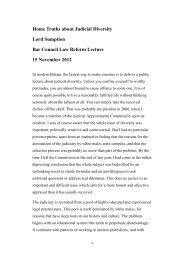



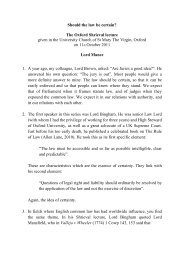
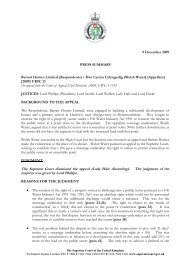
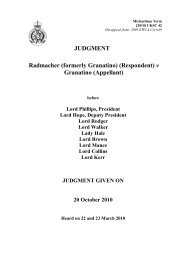
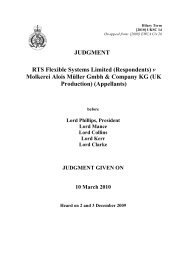

![[2009] UKSC 10 - The Supreme Court](https://img.yumpu.com/8582038/1/184x260/2009-uksc-10-the-supreme-court.jpg?quality=85)
